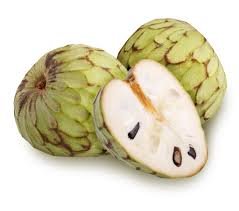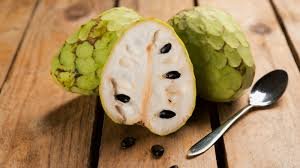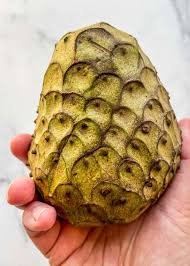 Image 1 of 3
Image 1 of 3

 Image 2 of 3
Image 2 of 3

 Image 3 of 3
Image 3 of 3




Cherimoya Trees (Annona Cherimola)
The cherimoya (botanical name Annona cherimola) is part of the Annonaceae or custard apple family. Native to the highland valleys between the Andes Mountains of Ecuador and Peru, cherimoyas spread throughout South and Central America, and then into Spain and other subtropical regions following the Spanish conquest in the 16th century. Today, cherimoyas are cultivated in many tropical and subtropical regions, including Central America, Chile, Spain, Bolivia, New Zealand, and Southern California.
These fruits were sourced from fruit sent to New Orleans via Miami and taste like a creamy, tropical ice cream.
The flavors can vary, depending on the variety, ranging from sweet to tangy. Most commonly, it is described as a blend of pineapple, banana, and peach. Hints of strawberry, apple, and vanilla may also peek through. When you pull it apart, you are sure to experience fruit nirvana, as it reveals an aromatic sumptuous flesh with a velvety custard consistency that gives it its secondary name, the custard apple.
Cherimoya are a little trickier than the other annonas, so check this out:
Growing Cherimoya in a Pot in Zone 9b (New Orleans)
Planting Cherimoya in a Pot
Pot Selection: Use a large pot (at least 24 inches deep and wide) with drainage holes.
Soil Requirements: Use loamy, well-draining soil with a slightly acidic to neutral pH (6.0-7.5). Mix in organic matter like compost.
Planting Process:
Fill the pot with soil, leaving space for the root ball.
Place the sapling at the same depth it was in the nursery pot.
Backfill with soil, tamp down lightly.
Water thoroughly and mulch the topsoil.
Caring for Your Cherimoya Tree
Watering: Water once or twice a week during growth periods, keeping the soil moist but not waterlogged. Reduce watering in winter.
Fertilizing: Use a balanced, slow-release fertilizer (10-10-10 NPK) every 2-3 months during the growing season. Supplement with organic compost in spring.
Pruning: Prune in late winter to remove dead, diseased, or crowded branches. Maintain an open center for sunlight.
Pollination
Cherimoya trees need cross-pollination:
Hand Pollination:
Collect pollen from male-stage flowers.
Transfer pollen to female-stage flowers using a small brush.
Repeat daily as new flowers open.
Harvesting
Timing: Ripens in fall or winter.
Indicators of Ripeness: Slightly soft texture, yellowish or light brown skin.
Technique: Use pruning shears to cut the stem, handle fruit gently.
Pest and Disease Management
Pests: Watch for aphids, scale insects, and mealybugs. Use water sprays, insecticidal soap, or neem oil.
Diseases: Prevent fungal infections with proper pruning, good air circulation, and well-draining soil.
Tips for Zone 9b (New Orleans)
Climate Needs: Cherimoya thrives in temperatures between 65°F and 85°F and needs protection from frost.
Sunlight: Ensure at least six hours of direct sunlight daily.
Winter Care: Move the pot to a sheltered location or indoors to protect from cold snaps.
Conclusion
Growing a cherimoya tree in a pot in Zone 9b, New Orleans, requires attentive care, but with the right conditions, you can enjoy this exotic fruit. Regular watering, fertilizing, and protection from pests and diseases will help your cherimoya tree thrive and bear delicious fruits. Happy gardening!
The cherimoya (botanical name Annona cherimola) is part of the Annonaceae or custard apple family. Native to the highland valleys between the Andes Mountains of Ecuador and Peru, cherimoyas spread throughout South and Central America, and then into Spain and other subtropical regions following the Spanish conquest in the 16th century. Today, cherimoyas are cultivated in many tropical and subtropical regions, including Central America, Chile, Spain, Bolivia, New Zealand, and Southern California.
These fruits were sourced from fruit sent to New Orleans via Miami and taste like a creamy, tropical ice cream.
The flavors can vary, depending on the variety, ranging from sweet to tangy. Most commonly, it is described as a blend of pineapple, banana, and peach. Hints of strawberry, apple, and vanilla may also peek through. When you pull it apart, you are sure to experience fruit nirvana, as it reveals an aromatic sumptuous flesh with a velvety custard consistency that gives it its secondary name, the custard apple.
Cherimoya are a little trickier than the other annonas, so check this out:
Growing Cherimoya in a Pot in Zone 9b (New Orleans)
Planting Cherimoya in a Pot
Pot Selection: Use a large pot (at least 24 inches deep and wide) with drainage holes.
Soil Requirements: Use loamy, well-draining soil with a slightly acidic to neutral pH (6.0-7.5). Mix in organic matter like compost.
Planting Process:
Fill the pot with soil, leaving space for the root ball.
Place the sapling at the same depth it was in the nursery pot.
Backfill with soil, tamp down lightly.
Water thoroughly and mulch the topsoil.
Caring for Your Cherimoya Tree
Watering: Water once or twice a week during growth periods, keeping the soil moist but not waterlogged. Reduce watering in winter.
Fertilizing: Use a balanced, slow-release fertilizer (10-10-10 NPK) every 2-3 months during the growing season. Supplement with organic compost in spring.
Pruning: Prune in late winter to remove dead, diseased, or crowded branches. Maintain an open center for sunlight.
Pollination
Cherimoya trees need cross-pollination:
Hand Pollination:
Collect pollen from male-stage flowers.
Transfer pollen to female-stage flowers using a small brush.
Repeat daily as new flowers open.
Harvesting
Timing: Ripens in fall or winter.
Indicators of Ripeness: Slightly soft texture, yellowish or light brown skin.
Technique: Use pruning shears to cut the stem, handle fruit gently.
Pest and Disease Management
Pests: Watch for aphids, scale insects, and mealybugs. Use water sprays, insecticidal soap, or neem oil.
Diseases: Prevent fungal infections with proper pruning, good air circulation, and well-draining soil.
Tips for Zone 9b (New Orleans)
Climate Needs: Cherimoya thrives in temperatures between 65°F and 85°F and needs protection from frost.
Sunlight: Ensure at least six hours of direct sunlight daily.
Winter Care: Move the pot to a sheltered location or indoors to protect from cold snaps.
Conclusion
Growing a cherimoya tree in a pot in Zone 9b, New Orleans, requires attentive care, but with the right conditions, you can enjoy this exotic fruit. Regular watering, fertilizing, and protection from pests and diseases will help your cherimoya tree thrive and bear delicious fruits. Happy gardening!
The cherimoya (botanical name Annona cherimola) is part of the Annonaceae or custard apple family. Native to the highland valleys between the Andes Mountains of Ecuador and Peru, cherimoyas spread throughout South and Central America, and then into Spain and other subtropical regions following the Spanish conquest in the 16th century. Today, cherimoyas are cultivated in many tropical and subtropical regions, including Central America, Chile, Spain, Bolivia, New Zealand, and Southern California.
These fruits were sourced from fruit sent to New Orleans via Miami and taste like a creamy, tropical ice cream.
The flavors can vary, depending on the variety, ranging from sweet to tangy. Most commonly, it is described as a blend of pineapple, banana, and peach. Hints of strawberry, apple, and vanilla may also peek through. When you pull it apart, you are sure to experience fruit nirvana, as it reveals an aromatic sumptuous flesh with a velvety custard consistency that gives it its secondary name, the custard apple.
Cherimoya are a little trickier than the other annonas, so check this out:
Growing Cherimoya in a Pot in Zone 9b (New Orleans)
Planting Cherimoya in a Pot
Pot Selection: Use a large pot (at least 24 inches deep and wide) with drainage holes.
Soil Requirements: Use loamy, well-draining soil with a slightly acidic to neutral pH (6.0-7.5). Mix in organic matter like compost.
Planting Process:
Fill the pot with soil, leaving space for the root ball.
Place the sapling at the same depth it was in the nursery pot.
Backfill with soil, tamp down lightly.
Water thoroughly and mulch the topsoil.
Caring for Your Cherimoya Tree
Watering: Water once or twice a week during growth periods, keeping the soil moist but not waterlogged. Reduce watering in winter.
Fertilizing: Use a balanced, slow-release fertilizer (10-10-10 NPK) every 2-3 months during the growing season. Supplement with organic compost in spring.
Pruning: Prune in late winter to remove dead, diseased, or crowded branches. Maintain an open center for sunlight.
Pollination
Cherimoya trees need cross-pollination:
Hand Pollination:
Collect pollen from male-stage flowers.
Transfer pollen to female-stage flowers using a small brush.
Repeat daily as new flowers open.
Harvesting
Timing: Ripens in fall or winter.
Indicators of Ripeness: Slightly soft texture, yellowish or light brown skin.
Technique: Use pruning shears to cut the stem, handle fruit gently.
Pest and Disease Management
Pests: Watch for aphids, scale insects, and mealybugs. Use water sprays, insecticidal soap, or neem oil.
Diseases: Prevent fungal infections with proper pruning, good air circulation, and well-draining soil.
Tips for Zone 9b (New Orleans)
Climate Needs: Cherimoya thrives in temperatures between 65°F and 85°F and needs protection from frost.
Sunlight: Ensure at least six hours of direct sunlight daily.
Winter Care: Move the pot to a sheltered location or indoors to protect from cold snaps.
Conclusion
Growing a cherimoya tree in a pot in Zone 9b, New Orleans, requires attentive care, but with the right conditions, you can enjoy this exotic fruit. Regular watering, fertilizing, and protection from pests and diseases will help your cherimoya tree thrive and bear delicious fruits. Happy gardening!